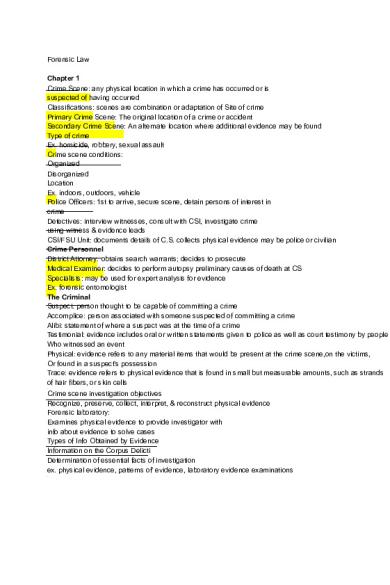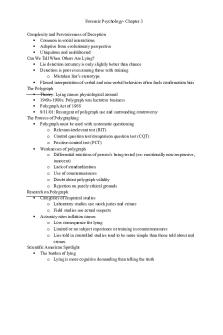forensic law chapter 1 notes PDF

| Title | forensic law chapter 1 notes |
|---|---|
| Author | Gabriella DiGiulio |
| Course | Forensic Law |
| Institution | Rowan University |
| Pages | 5 |
| File Size | 89 KB |
| File Type | |
| Total Downloads | 56 |
| Total Views | 123 |
Summary
Forensic law chapter 1 lecture notes describing the behind the scenes of crime scenes and the process of evidence...
Description
Forensic Law Chapter 1 Crime Scene: any physical location in which a crime has occurred or is suspected of having occurred Classifications: scenes are combination or adaptation of Site of crime Primary Crime Scene: The original location of a crime or accident Secondary Crime Scene: An alternate location where additional evidence may be found Type of crime Ex. homicide, robbery, sexual assault Crime scene conditions: Organized Disorganized Location Ex. indoors, outdoors, vehicle Police Officers: 1st to arrive, secure scene, detain persons of interest in crime Detectives: interview witnesses, consult with CSI, investigate crime using witness & evidence leads CSI/FSU Unit: documents details of C.S. collects physical evidence may be police or civilian Crime Personnel District Attorney: obtains search warrants; decides to prosecute Medical Examiner: decides to perform autopsy preliminary causes of death at CS Specialists: may be used for expert analysis for evidence Ex. forensic entomologist The Criminal Suspect: person thought to be capable of committing a crime Accomplice: person associated with someone suspected of committing a crime Alibi: statement of where a suspect was at the time of a crime Testimonial: evidence includes oral or written statements given to police as well as court testimony by people Who witnessed an event Physical: evidence refers to any material items that would be present at the crime scene,on the victims, Or found in a suspect’s possession Trace: evidence refers to physical evidence that is found in small but measurable amounts, such as strands of hair fibers, or skin cells •
Crime scene investigation objectives Recognize, preserve, collect, interpret, & reconstruct physical evidence Forensic laboratory: Examines physical evidence to provide investigator with info about evidence to solve cases Types of Info Obtained by Evidence Information on the Corpus Delicti Determination of essential facts of investigation ex. physical evidence, patterns of’ evidence, laboratory evidence examinations •
Information on the Modus Operandi Criminal’s method of operation Criminals tend to have repetitive behavior Proving or Disproving Witness Statements Credibility of witnesses, victims, suspects Physical evidence absence/presence = accuracy o’ statements •
Identification of Suspects Recognition, identification, individualization Individualization = comparison testing AFIS fingerprint CODIS DNA •
Identification of Unknown Substances Ex. drugs, poisons, bacteria Reconstruction of a Crime “how” a crime occurred •
Providing Investigating Leads Direct vs. Indirect Information Criminal Investigation Process Criminal investigation: The process of collecting crime related information to reach certain goals Process = activities performed Activities performed by patrol officers, detectives, or other investigators The nature and seriousness of the crime determines the activities to be performed Common activities these individuals perform include: Searching for victims and witnesses Interviewing for victims and witnesses Reading and writing reports Criminal evidence:defined as the facts and knowledge that are used to establish whether a crime was committed and who committed it Some evidence requires scientific analysis Forensic science: the field of scientific study that addresses legal questions Potential problems with evidence: Relevance Too much evidence Accuracy Types of Criminal Investigations Reactive Investigations: The crime occurs and then the police respond traditional strategy of the police Four stages of reactive investigations:
1. The discovery of the crime and police response 2. Initial investigation conducted 3. Follow up investigation can be conducted case is screened for its solvability factors: The seriousness of the crime The evidence available 4.Closure Criminal Investigation as a battle Information theory: perspective from which to understand the criminal investigation process The battle between the police and the perpetrator for crime related information Mistakes are critical Ex. evidence created by the beltway snipers Criminal Investigation as a game and puzzle As a game: strategic action as well as mistakes can change the outcome As a puzzle: a variety of pieces which have to be set together –Some pieces are missing –The pieces must be found –Some pieces do not belong to this puzzle The Role of Chance,Accident, and Discovery Accidents and good fortune have led to many solved crimes It is common to discover information about one crime when investigating a different one Ex. investigation of the 1993 world trade center Investigators use logic to solve problems by analyzing the dimensions of the problem and making inferences that draw accurate conclusions Mental Mistakes in Criminal Investigations Coincidences may actually be coincidences Confirmation bias: Where people tend to pay attention to the information that supports their opinions and perspectives while ignoring evidence to the contrary putting too much trust in potentially unreliable evidence ex.the use of victim/witness identification because it is incredibly persuasive yet often inaccurate Difficulty in changing one’s mindset about the crime or perpetrator when a theory has been developed Overconfidence bias People overestimate their own abilities Identified qualities and traits that make a good investigator: Common sense Motivation Integrity
Previous experience in law enforcement: Solid street knowledge Knowledge of the law Excellent oral and written communication skills Reading comprehension skills Each part of the criminal justice system (police, courts,corrections) has a specialized function. All need to function properly in order to reduce crime Criminal justice system can be described as a funnel Cases drop out as they progress through the system Either because the crime was not reported or the crime was not solved Why crimes are not reported to the police? Sometimes rape victims do not report because they claim the crime was a “personal matter” Sometimes robbery victims do not report because they claim the crime was “not important enough”...
Similar Free PDFs

forensic law chapter 1 notes
- 5 Pages

1- forensic anthro chapter 1
- 6 Pages

Forensic Psychology Chapter 3
- 3 Pages

2 Forensic Psychology Notes
- 45 Pages

Chapter 11 Forensic Science
- 2 Pages

Forensic Psychology Chapter 4
- 4 Pages

Forensic Psych Chapter 2
- 4 Pages

Chapter 6 Forensic Science
- 3 Pages

Mobile Forensic VANS - notes
- 13 Pages

Lecture 6 Forensic - NOTES
- 5 Pages
Popular Institutions
- Tinajero National High School - Annex
- Politeknik Caltex Riau
- Yokohama City University
- SGT University
- University of Al-Qadisiyah
- Divine Word College of Vigan
- Techniek College Rotterdam
- Universidade de Santiago
- Universiti Teknologi MARA Cawangan Johor Kampus Pasir Gudang
- Poltekkes Kemenkes Yogyakarta
- Baguio City National High School
- Colegio san marcos
- preparatoria uno
- Centro de Bachillerato Tecnológico Industrial y de Servicios No. 107
- Dalian Maritime University
- Quang Trung Secondary School
- Colegio Tecnológico en Informática
- Corporación Regional de Educación Superior
- Grupo CEDVA
- Dar Al Uloom University
- Centro de Estudios Preuniversitarios de la Universidad Nacional de Ingeniería
- 上智大学
- Aakash International School, Nuna Majara
- San Felipe Neri Catholic School
- Kang Chiao International School - New Taipei City
- Misamis Occidental National High School
- Institución Educativa Escuela Normal Juan Ladrilleros
- Kolehiyo ng Pantukan
- Batanes State College
- Instituto Continental
- Sekolah Menengah Kejuruan Kesehatan Kaltara (Tarakan)
- Colegio de La Inmaculada Concepcion - Cebu





